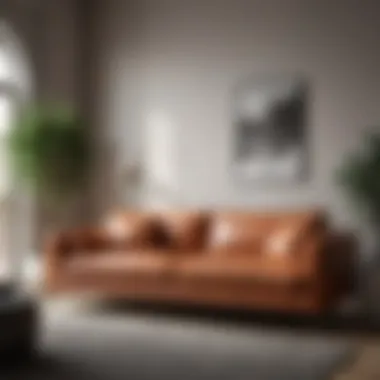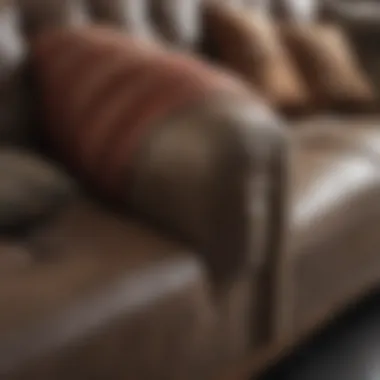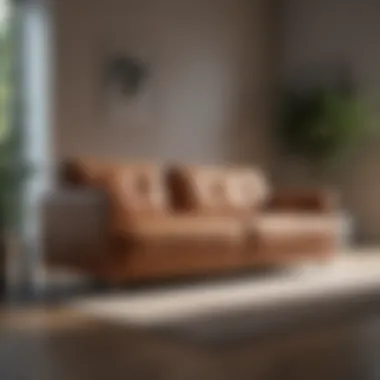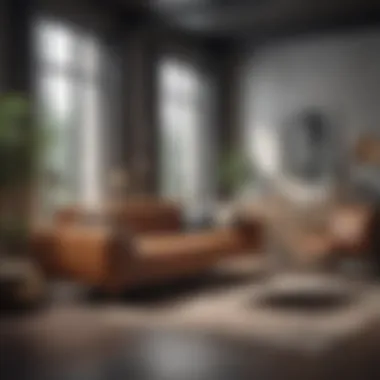Contemporary Sofa Ideas for Modern Living Spaces


Intro
Modern living spaces demand furniture that is not only functional but also aesthetically pleasing. Sofas, serving as the centerpiece of most living rooms, play a crucial role in defining the style of the space. Today’s homeowners and design aficionados increasingly seek sofas that marry style with versatility, functionality, and comfort. As we explore contemporary sofa ideas, we will look closely at design inspiration, materials, and current trends, ultimately guiding you to make more informed choices for your living environment.
Design Inspiration
When contemplating contemporary sofas, inspiration can often be drawn from trends that emphasize minimalism, comfort, and innovation.
Trending Styles and Themes
Several styles currently prevail in the market. You can find muted tones in sleek modular sofas which cater to compact living spaces without sacrificing comfort. These elegant pieces often allow for various arrangements, adding functionality. Moreover, vintage themes are returning with a modern twist, making use of reclaimed materials, which appeal to eco-conscious consumers. Some popular styles include:
- Mid-century Modern: Characterized by clean lines and organic shapes.
- Scandinavian: Simple designs that focus on functionality and understated elegance.
- Industrial: Features materials such as leather and metal, giving a loft-like vibe.
A common theme in these styles is the balance of form and function. Homeowners today prefer furniture that offers adaptability in various settings, whether for casual gatherings or more formal occasions.
Color Palettes and Combinations
When selecting a sofa, the color should complement the overall theme of your living area. Neutral shades like greys, beiges, and whites create a calm backdrop, allowing you to introduce vibrant accents through cushions or decorative elements. On the other hand, bold hues can make a strong statement. For instance:
- Deep Blues and Rich Greens: Add elegance and depth.
- Terracotta and Mustard Yellow: Bring warmth and a touch of coziness.
Combining complementary tones in a single space can tie together your design. Think about a pastel sofa paired with soft earth tones for a harmonious feel.
"The right sofa can transform a living space, making it not just a room but an experience in comfort and style."
Preamble to Modern Sofa Designs
In modern interiors, the sofa serves not only as a central seating element but also as a statement piece that enhances the overall aesthetic. The importance of modern sofa designs lies in their ability to seamlessly blend form and function. They can transform a living space, reflecting personal style while accommodating practical needs. This article discusses various aspects of modern sofas, helping homeowners and designers appreciate the depth these pieces can add to contemporary spaces.
Defining Modern Aesthetics
Modern aesthetics prioritize simplicity, functionality, and uncluttered spaces. In contrast to traditional styles, modern sofas often feature clean lines and geometric shapes. They embrace minimalism, steering clear of ornamental elements that may clutter the design. Color palettes are typically neutral, allowing the sofa to blend into the surrounding decor, or offer a bold contrast as needed.
Several defining characteristics influence this aesthetic:
- Material Quality: The use of high-quality materials is essential. Whether leather or fabric, the sofa's texture and feel play a role in its visual appeal.
- Proportion and Scale: The size of the sofa should align with the room's scale. A large sectional may dominate a small room, detracting from the comfort and flow of the space.
- Functionality: Multi-use sofas, such as those with storage or convertible features, reflect modern lifestyles where efficiency is key.
The Evolution of Sofa Styles
The design of sofas has undergone significant changes throughout history, influenced by social trends, technological advancements, and individual tastes. Traditional sofas emphasized elaborate woodwork and intricate patterns. However, the shift towards modern design began in the early 20th century.
- Early 20th Century: Movements like Bauhaus introduced functionalism, advocating for designs that serve users' needs without unnecessary decoration.
- Post-War Boom: The mid-century modern movement brought iconic designs, such as the Eames Lounge Chair, emphasizing organic forms and innovative materials.
- Contemporary Trends: Today, the focus is on sustainable practices and versatile designs. Sofas are now being crafted with eco-friendly materials and customizable features, accommodating diverse tastes.
Understanding this evolution helps in recognizing not only trends but also the reasons behind them. Modern sofa designs reflect a cultural shift towards practicality and sustainability while maintaining a strong aesthetic appeal.
Key Characteristics of Modern Sofas
Understanding the key characteristics of modern sofas is essential when designing contemporary living spaces. These features reflect not just aesthetics but also the functional needs of today’s households. Modern sofas aim to balance style and comfort while addressing the dynamics of space usage and lifestyle. By grasping these characteristics, homeowners can make informed decisions that elevate their interior choices.
Clean Lines and Minimalism
Clean lines and minimalism serve as the foundation of modern sofa design. They embody simplicity and functionality, producing an uncluttered yet sophisticated look. Sofas with straight edges and geometric shapes create visual harmony in a room.
This minimalistic approach encourages versatility, as these sofas can seamlessly integrate into both large and small spaces. Additionally, they allow for easy styling with various decorative elements, such as throws or cushions, without overwhelming the overall design. Designers often emphasize neutral colors and smooth textures, further enhancing this minimalist ethos.
Functional Design Elements


Functionality has become a paramount consideration in modern sofa design. Many contemporary sofas feature modular arrangements, allowing homeowners to customize layouts based on their unique space requirements.
For instance, convertible sofas that transform into beds or those equipped with storage compartments maximize utility without sacrificing style. This practicality is particularly advantageous in urban environments where space can be limited.
Features such as built-in charging stations provide further benefit, meeting the needs of a tech-savvy society. These design elements make modern sofas not only attractive but also highly adaptable to evolving lifestyles.
Innovative Use of Materials
The materials used in modern sofas reflect advancements in both aesthetics and sustainability. Designers increasingly opt for materials that are not just visually appealing but also eco-friendly. Natural fibers such as organic cotton or linen are preferred for their sustainable attributes.
In addition, synthetic materials like recycled polyester are gaining traction. These fabrics offer durability while being easy to maintain. The combination of these materials enhances the overall longevity of the product, which is a significant benefit for any homeowner.
Furthermore, the innovative use of textures, such as blending smooth leather with soft textiles, creates a unique tactile experience. This results in sofas that are both comfortable and striking.
The modern sofa is not just a piece of furniture; it is a centerpiece that encapsulates style, comfort, and functionality.
Overall, recognizing these key characteristics can aid homeowners and design enthusiasts in selecting the right modern sofa that fits within their living space, ultimately creating a balanced and cohesive environment.
Selecting the Right Sofa Material
Choosing the right sofa material is crucial in creating a modern living space that is not only stylish but also functional. The fabric or leather you select can significantly influence the sofa's appearance, durability, and overall maintenance needs. When considering various materials, it is essential to reflect on your lifestyle, budget, and the aesthetics you wish to achieve. Understanding the qualities of different materials will empower you to make an informed decision that complements your space.
Natural Fibers vs. Synthetics
Natural fibers, such as cotton, linen, and wool, offer a unique appeal. They tend to be breathable, soft, and comfortable. However, they may require more maintenance compared to synthetics. Natural materials can fade in sunlight, attract stains, and may not be as durable in high-traffic areas.
On the other hand, synthetic fabrics like polyester and nylon provide an array of advantages. They are often more affordable, resistant to stains, and come in a variety of colors and patterns. Additionally, synthetics are typically easier to clean and maintain. Thus, if you have children or pets, synthetic options could be a better fit.
"The choice between natural fibers and synthetics often hinges on individual preferences for comfort versus practicality."
Leather: Timeless Elegance
Leather has long been regarded as a symbol of luxury and sophistication. Its rich texture and elegant look contribute to a modern aesthetic. Leather sofas are generally durable, resistant to wear, and can age beautifully, developing a unique patina over time. However, they may require occasional conditioning and can be susceptible to scratches or heat damage. They also can be priced higher than fabric alternatives.
When selecting leather, it is wise to consider the type. Full-grain leather is the highest quality, retaining the hide's natural surface, while bonded leather is more affordable but less durable. This distinction can impact both appearance and longevity.
Performance Fabrics: Durability and Ease
Performance fabrics are increasingly becoming popular in contemporary sofa choices. These materials are specifically engineered to withstand wear and tear, making them ideal for high-use areas. They offer the softness of traditional fabrics while providing stain resistance and easy cleaning.
Often incorporating advanced technologies, performance fabrics resist water, fading, and even stains. This makes them an excellent choice for families, pet owners, or anyone looking for a maintenance-free option. These fabrics come in diverse styles and colors, blending functionality with modern design.
In summary, selecting the right sofa material requires careful consideration of durability, maintenance, and aesthetics. By understanding the benefits and drawbacks of options like natural fibers, leather, and performance fabrics, you can find the perfect fit for your contemporary living space.
Incorporating Sofas into Various Spaces
When selecting a sofa, it is vital to consider the specific space it will inhabit. Sofas serve as focal points in a room, dictating both style and comfort. Understanding how to incorporate them into various environments can enhance a living area significantly. Whether it is a small living room, an open concept layout, or a home office, the right sofa will combine aesthetics with functionality, making every space feel intentional and complete.
Small Living Rooms
In a small living room, maximizing space is essential. The use of a compact, sleek sofa can create an impression of openness. Selecting a two-seater or an L-shaped sofa can be practical, fitting neatly into corners or against walls. A lower profile sofa can also help make the ceiling feel higher.
To optimize comfort without crowding, it’s helpful to choose a sofa with built-in storage options, such as drawers or a hidden compartment under the cushions. Light colors can also aid in making the space seem larger. Adding a few strategically placed mirrors can reflect light and make the area feel more expansive. The focus should remain on simplicity and utility, allowing the space to feel airy and inviting.
Open Concept Layouts
Open concept layouts have become increasingly popular in modern homes. They offer versatility and facilitate social interactions. In such spaces, a sofa serves as a bridge between different functional areas, such as dining and living. The choice of sofa becomes more significant, as it must complement various design elements.
A sectional sofa can create defined zones without obstructing flow. Bold upholstery or distinct textures can help anchor the living area, drawing attention. Additionally, consider the layout; sofas can be positioned to promote conversation or viewing angles towards a television or fireplace. Use area rugs to delineate the sofa’s space, creating a cozy atmosphere that invites relaxation.


Home Offices and Multipurpose Spaces
In today’s world, many people utilize their homes for work. Therefore, incorporating a sofa into a home office or multipurpose space is becoming increasingly common. A sofa can provide a place for informal meetings or a relaxing area for breaks.
Choosing a functional design is key. A sleeper sofa, for instance, can transform a home office into a guest space. When considering colors and materials, opt for soft yet durable fabrics that accommodate both work and leisure. Position the sofa in a well-lit area, allowing ample natural light. It should serve as both a comfortable seating option and an element of design that enhances productivity and creativity.
Ultimately, the incorporation of sofas into various spaces goes beyond mere aesthetics. It involves creating functional environments that cater to living, working, and interacting with others.
Current Trends in Modern Sofas
In the field of interior design, keeping abreast of current trends in modern sofas is more than a mere aesthetic consideration. These trends often reflect broader cultural shifts, environmental consciousness, and evolving lifestyle needs. Sofas today are not just pieces of furniture; they are integral components of living spaces that need to accommodate flexibility, comfort, and even sustainability. As we delve into various current trends, we explore their significance and implications for modern living environments.
Sustainable Practices in Sofa Production
Sustainability has first risen as a critical concern in all areas of product design, including sofas. The shift toward sustainable practices in sofa production encompasses the use of eco-friendly materials, ethical sourcing, and environmentally-responsible manufacturing processes. This trend is important for several reasons. First, it addresses growing consumer skepticism about the impacts of mass production on the environment.
Moreover, sustainable sofas often feature:
- Recycled materials: This may include upholstery made from recycled fabrics or wood sourced from sustainably managed forests.
- Low-Waste Construction: Companies are focusing on methods that minimize waste during production, ensuring that every component of the sofa has a purpose.
- Reparability: A major focus in the sustainable movement is designing sofas that can easily be repaired, extending their lifecycle and reducing landfill waste.
By investing in sustainable sofas, homeowners not only enhance their living spaces but also contribute positively to the environment.
Modular Sofas: Customizable Comfort
Another trend gaining prominence is the modular sofa design. Modular sofas allow for a high degree of customization, catering to diverse spatial needs and personal preferences. This type of sofa can be rearranged in different configurations, adapting easily to different settings or occasions. This flexibility is especially beneficial in contemporary homes, where multipurpose spaces are common.
The benefits of modular sofas include:
- Versatility: Homeowners can modify their sofa layout based on social gatherings, daily needs, or room size changes.
- Easy Transportation: Modular components are easier to move, making this type of sofa ideal for individuals who relocate frequently.
- Expanded Options: Modular designs often offer diverse fabric choices and color combinations, enabling personalization help to reflect individual style effectively.
As life becomes increasingly dynamic, modular sofas meet the need for both functional and aesthetic flexibility.
Bold Colors and Patterns
In recent years, the use of bold colors and patterns has become a defining characteristic of modern sofas. Traditionally, neutral tones dominated furniture design, but current trends encourage embracing vibrant colors and eye-catching patterns to make a statement.
Incorporating bold colors can:
- Create a Focal Point: A brightly colored sofa can act as the centerpiece of a room, drawing eyes and establishing an atmosphere.
- Enhance Mood: Colors have psychological effects; warm hues can stimulate energy and enthusiasm, whereas cool tones can promote calmness.
- Reflect Personal Style: Unique patterns and colors display the homeowner's personality and preferences, making the space uniquely theirs.
Many designers recommend positioning such bold pieces against neutral backgrounds to maximize their impact while avoiding overwhelming the space.
"Incorporating a bold sofa can transform an otherwise standard space into a distinctive environment."
The exploration of these trends highlights the evolving role of sofas within contemporary homes. They have become much more than practical seating; they are versatile design elements that foster sustainability, customization, and vibrant personal expression.
Styling Your Modern Sofa
Styling your modern sofa is crucial in creating a cohesive aesthetic in contemporary living spaces. Sofas are often the focal point of a room; thus, how they are styled can influence the overall vibe and comfort of the space. By choosing the right accessories and arrangement techniques, one can enhance the sophistication and functionality of the sofa.
In this section, we will discuss several key elements that contribute to styling a modern sofa. These include textile layering techniques, integrating art and accessories, plus positioning for aesthetic balance. Each element plays a role in elevating the visual appeal and ensuring comfort, making it essential for homeowners and design enthusiasts alike.
Textile Layering Techniques
Using Throws
Using throws is a simple yet effective method to enhance the look of a sofa. They add texture, color, and warmth, making the sofa feel more inviting. An important characteristic of throws is their versatility. They can be changed seasonally, allowing for easy updates to your decor. For example, heavier, knit throws are popular in winter, while lighter, breathable throws work well in summer.


Throws also offer practical benefits. They can be used for extra warmth during chilly evenings, adding an element of comfort. However, one must choose appropriate fabrics; some materials may not hold up well over time or could require more frequent washing. To summarize, throws are a beneficial choice for adding dimension and utility to a modern sofa.
Decorative Cushions
Decorative cushions are another essential component when styling a modern sofa. They provide an opportunity to introduce patterns and colors that can both contrast and complement the sofa's design. A key feature of decorative cushions is their ability to transform the look of a sofa almost instantly. Mixing different sizes and shapes adds visual interest and creates an inviting atmosphere.
The unique advantage of cushions is their modular nature; they can be rearranged or swapped out simply. On the downside, too many cushions can overcrowd a sofa, detracting from its sleek lines. Careful consideration is required to maintain balance in styling. Overall, decorative cushions are a popular choice for homeowners looking to personalize their space while ensuring comfort.
Integrating Art and Accessories
Integrating art and accessories alongside your modern sofa can significantly enhance the living space. Wall art, for instance, should harmonize with the sofa's color scheme. Selecting pieces that resonate with your personal aesthetic can create a dialogue between the sofa and artwork. Accessories, such as plants, books, or decorative items, can also be displayed on side tables or the sofa itself. This helps to create layers and texture, making the space feel more dynamic.
Positioning for Aesthetic Balance
Positioning your sofa is important for achieving aesthetic balance in a room. This involves considering the flow of the space, light sources, and other furniture. A well-positioned sofa not only allows for easy movement but also draws the eye naturally and encourages conversation. Ensure that the sofa is not too far from key areas, such as the television or dining space, to maintain functionality.
Achieving balance may require minor adjustments. For example, if a sofa feels too heavy on one side, consider adjusting other elements in the room to redistribute visual weight. Keeping these aspects in mind enhances both the beauty and the usability of your modern living space.
Maintenance and Care of Modern Sofas
Proper maintenance and care of modern sofas is essential to extending the lifespan and beauty of these important pieces of furniture. Sofas are often the focal point in a living space, so their condition can significantly impact the overall aesthetic. Regular upkeep can prevent wear and tear, saving homeowners from costly replacements. Moreover, well-cared sofas provide comfort and a welcoming environment for guests. Understanding how to properly maintain these items is crucial.
Regular Cleaning and Care
Cleaning modern sofas regularly is not just about appearance; it is also about hygiene. Dust and allergens can accumulate in fabric, affecting indoor air quality. The first step is to vacuum the sofa using an upholstery attachment to gently remove dirt and debris. Pay special attention to crevices where crumbs may hide. For fabric sofas, a soft brush can help release particles trapped in the fibers.
It is also advisable to check the manufacturer's guidelines on cleaning. Some materials may require specific cleaners or methods. For instance, performance fabrics might benefit from a mild soap solution, while leather surfaces often need dedicated leather cleaners. An occasional deep cleaning—professional or DIY—can enhance the material’s longevity.
Handling Stains and Wear
Stains and wear are inevitable, especially in homes with pets or children. Quick action is vital in dealing with spills. Blot rather than rub the stain to avoid spreading it. Use a clean, dry cloth to absorb as much liquid as possible. For tough stains, a specially formulated cleaner for the fabric type is best.
For minor wear, consider using a fabric refresher or a conditioner for leather sofas to maintain suppleness. Regular inspections can help spot loose seams or fading colors. Addressing these issues early can prevent larger problems down the line.
"Regular maintenance not only keeps your sofa looking new but also significantly extends its life."
In summary, maintenance and care should be prioritized as part of the ownership of modern sofas. With proper cleaning techniques and prompt attention to issues, homeowners can keep their sofas in great condition for many years.
Ending: Elevating Your Living Space with Modern Sofas
Modern sofas play a critical role in the aesthetic and functional value of contemporary living spaces. The right choice of sofa can serve as a focal point for a room, complementing other design elements while providing comfort and usability. This article underscores the diverse ways in which modern sofas can transform a space, catering to various styles and needs.
Understanding how to select and integrate modern sofas into your home environment is essential. Quality design is not just about aesthetics; it also encompasses durability and functionality. Investing in a good sofa can elevate not only the look of a room but also enhance the overall experience of living in that space.
Here are few specific elements to consider:
- Proportionality: Ensure the sofa's size aligns with your space. A large sofa may overwhelm a smaller room, while a petite sofa could be lost in a larger area.
- Style Cohesion: The sofa should harmonize with existing decor, such as color schemes and textures.
- Functionality: Modern sofas often feature added functions, like storage or convertible designs. Consider how the sofa fits into daily life.
Modern sofas cater to the practical aspects of contemporary living, broadening their appeal to a range of homeowners. By understanding and utilizing these elements, one can achieve a balance of style and comfort.
The Lasting Impact of Quality Design
Quality design extends beyond mere appearance. It embodies craftsmanship, material selection, and sustainability. Modern sofas made with durable materials endure the test of time. They can withstand wear from frequent use while retaining their aesthetic appeal.
The influence of well-designed sofas can also be seen in the mood and functionality of a room. A comfortable and inviting sofa encourages relaxation and social interaction. The importance of selecting a sofa that embodies quality cannot be overstated.
Moreover, investing in a quality piece contributes to sustainable practices. Higher-quality sofas tend to last longer, which reduces waste in landfills.
Future Directions in Sofa Design
As we look ahead, the evolution of sofa design continues to adapt to changing lifestyles and technological advancements. One significant trend is the integration of smart technology into furniture. Sofas that incorporate USB ports, Bluetooth capabilities, and adjustable features are becoming more common.
Another trend lies in the emphasis on environmental sustainability. Manufacturers are responding to market demand by sourcing eco-friendly materials and using recycled components, leading to sofas that are both elegant and responsible.
Customization options are also expanding. Consumers are increasingly seeking modular designs that allow for personalization in size, shape, and fabric. This trend reflects a desire for individuality in home styling.



